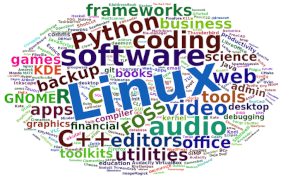Last Updated on May 22, 2022
Point Release Distro v Rolling Release Distro
A point release distro puts out installation images under a regular schedule. Often this can be every 6 or 9 months. Each release is given a unique name. Between these major releases only security patches and updates are released, although specific applications may get more frequent updates such as Firefox, Chrome, and LibreOffice.
Pros of a Point Release Distro:
 Stability – this distribution model has the opportunity for more end user testing of each release. Each release uses older, better tested software.
Stability – this distribution model has the opportunity for more end user testing of each release. Each release uses older, better tested software. Compatibility – most hardware is supported. It’s fairly uncommon for new hardware not to be supported by the latest distro point release, although there can be issues with specific types of hardware found in laptops.
Compatibility – most hardware is supported. It’s fairly uncommon for new hardware not to be supported by the latest distro point release, although there can be issues with specific types of hardware found in laptops. Convenience – you want to minimise disturbance from updates with less maintenance required. This may be an important factor depending on your skill set.
Convenience – you want to minimise disturbance from updates with less maintenance required. This may be an important factor depending on your skill set. Upgrades – many point release distros offer an upgrade path from one point release to another without having to wipe the system and reinstall.
Upgrades – many point release distros offer an upgrade path from one point release to another without having to wipe the system and reinstall. Possibility for Long Term Support (LTS) offering a greater period of support for a release. Efforts are made to stabilise the release early by significantly limiting the amount of new features, and avoiding structural changes as far as possible.
Possibility for Long Term Support (LTS) offering a greater period of support for a release. Efforts are made to stabilise the release early by significantly limiting the amount of new features, and avoiding structural changes as far as possible.
A rolling release distro is continuously updated in all areas, including the kernel, and all software applications such as the desktop environment, multimedia, utilities, and development tools. The distribution of installation images serves only as a starting point for a new system.
Pros of a Rolling Release Distro:
 Latest hardware support – this may be an important factor if you have a new computer (particularly laptops) that has specific hardware (such as touchpads, wireless network adapters and graphic display controllers) which are not recognized with older versions of the Linux kernel.
Latest hardware support – this may be an important factor if you have a new computer (particularly laptops) that has specific hardware (such as touchpads, wireless network adapters and graphic display controllers) which are not recognized with older versions of the Linux kernel. Software – offers the possibility of the most current versions of software. This may include programs which are generally not included in the periodic updates of a “point distro”. The latest versions may offer essential new features you need, fix bugs, improve security, and more.
Software – offers the possibility of the most current versions of software. This may include programs which are generally not included in the periodic updates of a “point distro”. The latest versions may offer essential new features you need, fix bugs, improve security, and more. Upgrade – often this process is painless and incremental although there’s the possibility of more maintenance required given that updates are more frequent.
Upgrade – often this process is painless and incremental although there’s the possibility of more maintenance required given that updates are more frequent.
In the next article we walk you through installing a distro.
Pages in this article:
Page 1 – Hardware / Beginner Friendly Distros
Page 2 – Point Release Distro v Rolling Release Distro
All articles in this series:
 Read our complete collection of recommended free and open source software. Our curated compilation covers all categories of software. Read our complete collection of recommended free and open source software. Our curated compilation covers all categories of software. Spotted a useful open source Linux program not covered on our site? Please let us know by completing this form. The software collection forms part of our series of informative articles for Linux enthusiasts. There are hundreds of in-depth reviews, open source alternatives to proprietary software from large corporations like Google, Microsoft, Apple, Adobe, IBM, Cisco, Oracle, and Autodesk. There are also fun things to try, hardware, free programming books and tutorials, and much more. |

I really believe that KDE Neon or Kubuntu should be included as beginner friendly distros. KDE plasma is very familiar to windows users. Deepin and Ubuntu Mate should be also considered. Deepin is in my opinion the most beautiful desktop environment by far (although I use KDE for its flexibility and the low resources usage when compared with all other future rich desktops).
The most critical criteria in choosing a Linux distribution is the reasons or plans that new user has for their use of Linux.
If the choice is for evaluating Linux for everyday productivity, a small organization or business over which they exert some controlling decision making, those criteria will be completely different for someone who simply wants to “play around” with Linux. In this latter category, there will also be differentiation in distributions depending if user is a seasoned Microsoft Windows or an Apple Mac user as compared to one that is a complete neophyte that even has difficulty in using Windows for simple tasks. Such person maybe directed to one of the great Linux distributions that mimic the simplicity of operation and intuitiveness of Apple Mac user interface, but generally such person should be strongly discouraged from the Linux realm.
The second consideration, related to preceding points should be for Linux supported software features functionality that will allow new user to be fully productive and efficient in their use of Linux. This is the point that consideration of hardware is needed that fully supports distribution selection.
In many cases It is a fools errand for many Linux consultants, advisors or hardware vendors in attempting to seduce “died-in-the-wool” Microsofties to adopt Linux, since no matter the incredible features, functionality, reliability, security and great Return-on-Investment” presented by a solid Linux distribution, this group will almost consistently complain about any Linux distribution as crap compared to their beloved Windows OS.
In more than twenty years in professional technology services, specializing for much of the time with Linux and FreeBSd for small business and organizations, academia and municipal government, the greatest success in recommending or aiding in the adoption of linux has been when the potential new users have a clear understanding of the significant benefits of Linux, combined with the great exasperation they had been experiencing with the disaster names Microsoft Windows – desktop or server, especially when reminded about Ransomware, viruses, Trojans, Worms, constantly broken updates and phishing attacks.
Well– The average Windows box will have a 3 G plus micro with 16 G plus ram. So any linux would install easy and have lots of room to grow.
The ‘average’ Windows box does not have 16GB of RAM. There are also millions of computers in regular use with less than 8GB of RAM.
I would not tell people coming from Windows to use standard Ubuntu. WinXP, Win7 and even Win10 users will want to use a more traditional desktop. KDE, LXDE, Cinnamon, Mate, and Xubuntu would all be better alternatives than Gnome. I would also never tell a person coming from Windows to install a different desktop than the one they download, but to download the new .iso and run it in the live mode to see which one they prefer. While the tutorial is good for somethings, I think it will send the average Windows user running back to Windows.
“… send the average Windows user running back to Windows”. Do you actually have any evidence at all to back up that assertion? No… I didn’t think so.
If a Windows user wants a carbon copy Windows, they should just stick to Windows.
Ubuntu is a good choice for a beginner to Linux. If a new user wants a different desktop environment to GNOME (in some way to mimic Windows), they can easily install it under Ubuntu with a couple of commands.
We cover how to install different desktop environments in Part 16 of this guide.